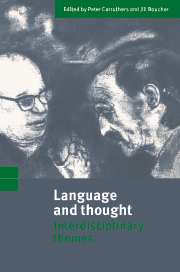Book contents
- Frontmatter
- Contents
- List of contributors
- Preface
- 1 Introduction: opening up options
- Part I Language, development and evolution
- Part II Language, reasoning and concepts
- Part III Language and conscious reasoning
- Introduction to part III
- 11 Language, thought and the language of thought (Aunty's own argument revisited)
- 12 Natural language and virtual belief
- 13 The meta-intentional nature of executive functions and theory of mind
- 14 Reflections on language and mind
- References
- Author index
- Subject index
12 - Natural language and virtual belief
Published online by Cambridge University Press: 08 January 2010
- Frontmatter
- Contents
- List of contributors
- Preface
- 1 Introduction: opening up options
- Part I Language, development and evolution
- Part II Language, reasoning and concepts
- Part III Language and conscious reasoning
- Introduction to part III
- 11 Language, thought and the language of thought (Aunty's own argument revisited)
- 12 Natural language and virtual belief
- 13 The meta-intentional nature of executive functions and theory of mind
- 14 Reflections on language and mind
- References
- Author index
- Subject index
Summary
Introduction
It is sometimes claimed that we can think in natural language – that natural language sentences can act as vehicles of thought and that we can think by tokening them – usually in the form of silent auditory or articulatory images (see, for example, Bickerton, 1995; Carruthers, 1996a; Harman, 1973.) There is some introspective evidence for this view (which is sometimes called the cognitive conception of language), and, given a certain view of what it is for thought to be conscious, a powerful argument can be run to the conclusion that conscious propositional thinking occurs in natural language (see Carruthers, 1996a).
Now, defence of the cognitive conception usually proceeds in two stages. First, it is argued that thought-processes are computational in character, the computations in question being understood as occurring at a subpersonal level. It is then argued that, in some thought-episodes at least, the medium of computation is natural language. In this chapter I shall outline an alternative way of arguing for the cognitive conception. The argument will not require a defence of computationalism, but will start with the claim that some intentional states are actively formed.
The chapter falls into two halves. The first aims to show that some beliefs, or belief-like states, are actively formed. I begin by describing two psychological phenomena which seem to have an active dimension. Then, following a suggestion by Daniel Dennett, I go on to develop a unified account of these phenomena, based around the idea that there exists a class of virtual beliefs, formed by actively adopting policies of premising. The second half of the chapter aims to show that virtual belief formation will typically involve natural language.
- Type
- Chapter
- Information
- Language and ThoughtInterdisciplinary Themes, pp. 248 - 269Publisher: Cambridge University PressPrint publication year: 1998
- 5
- Cited by

